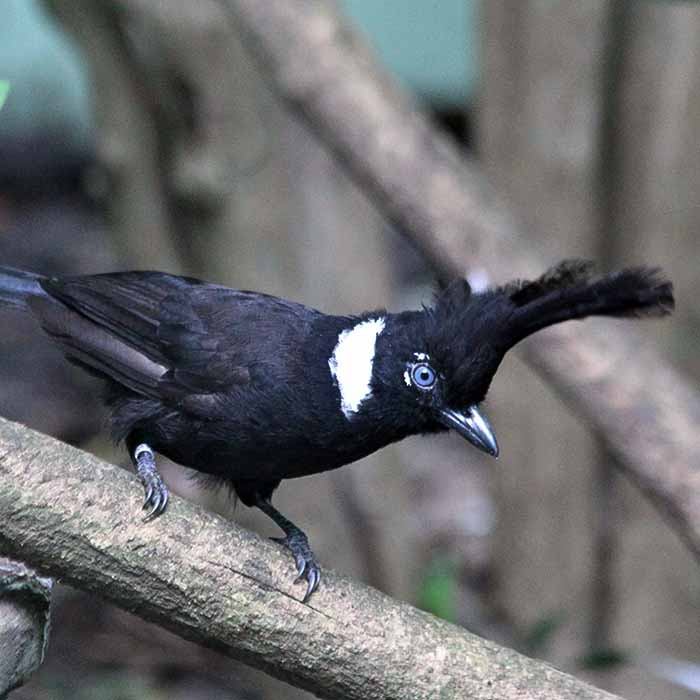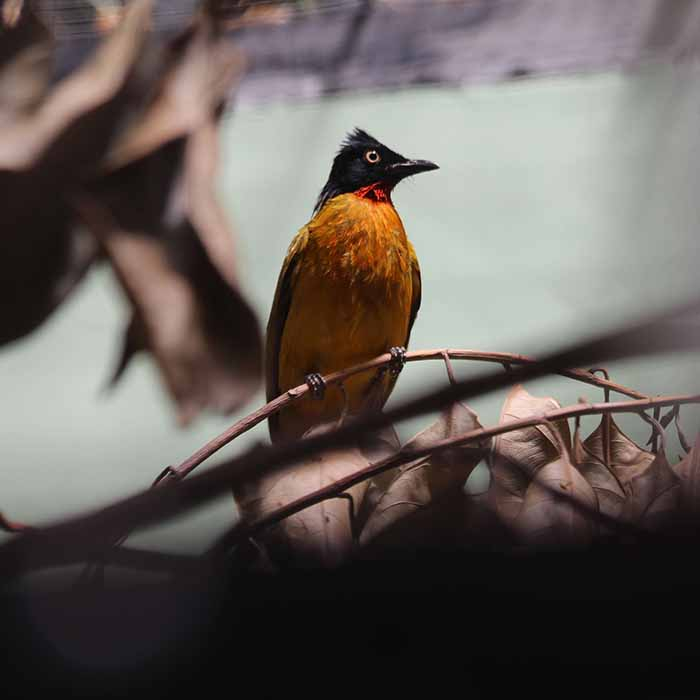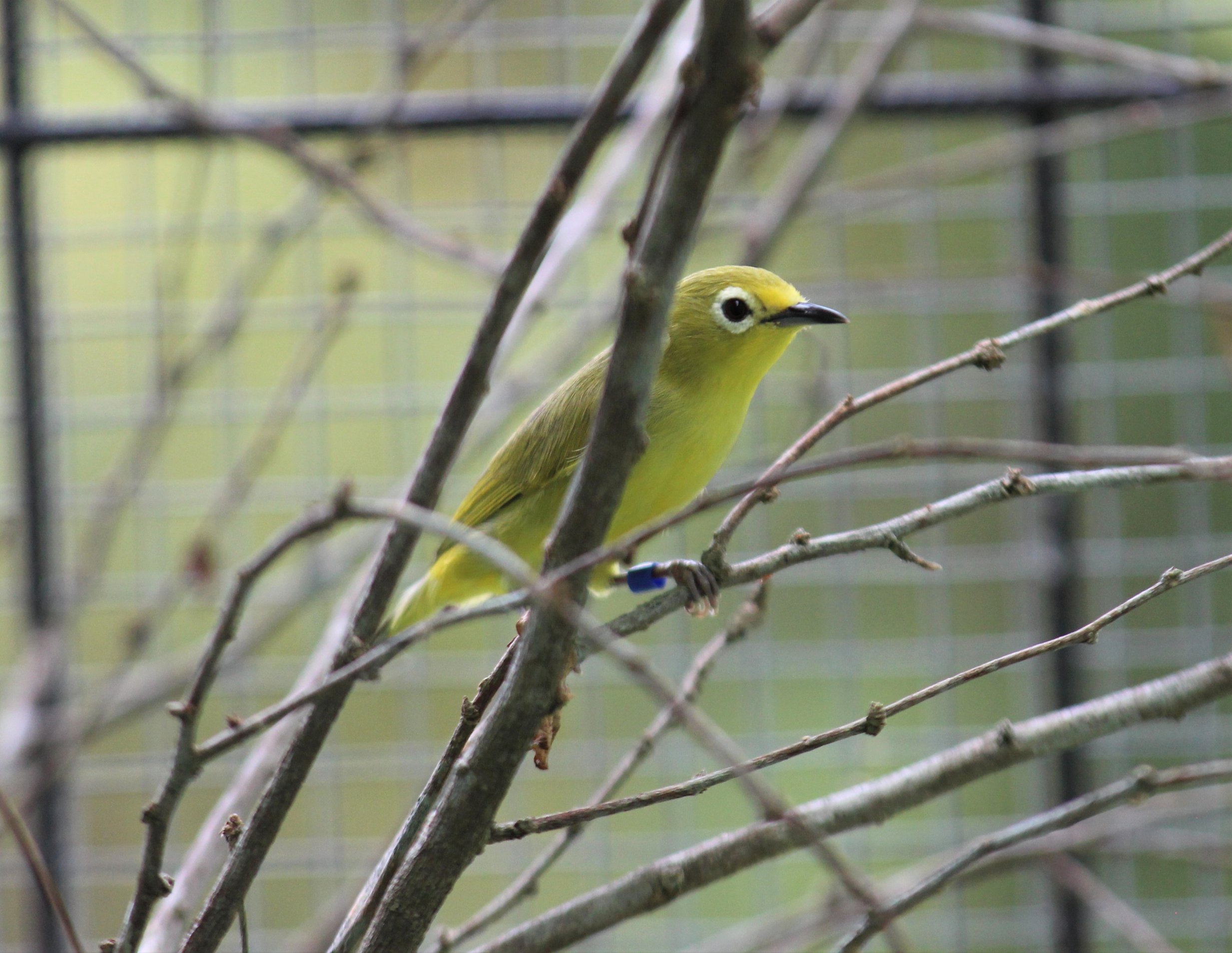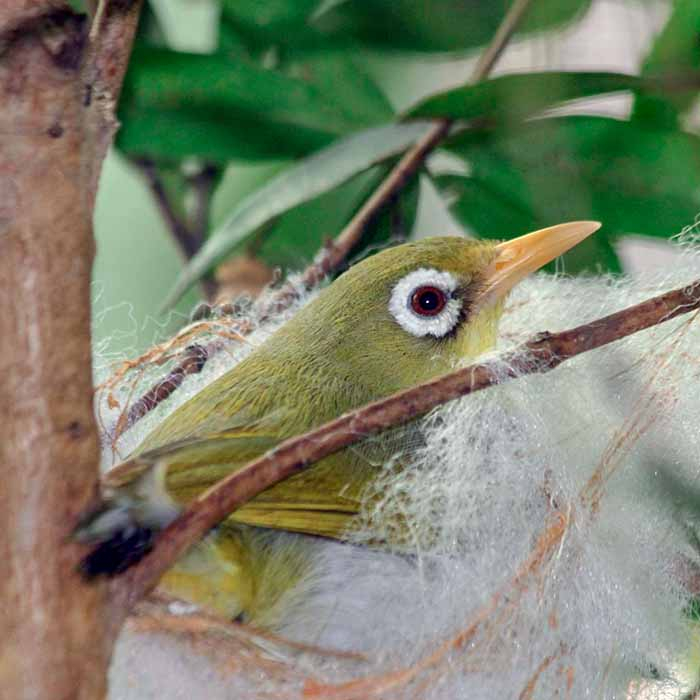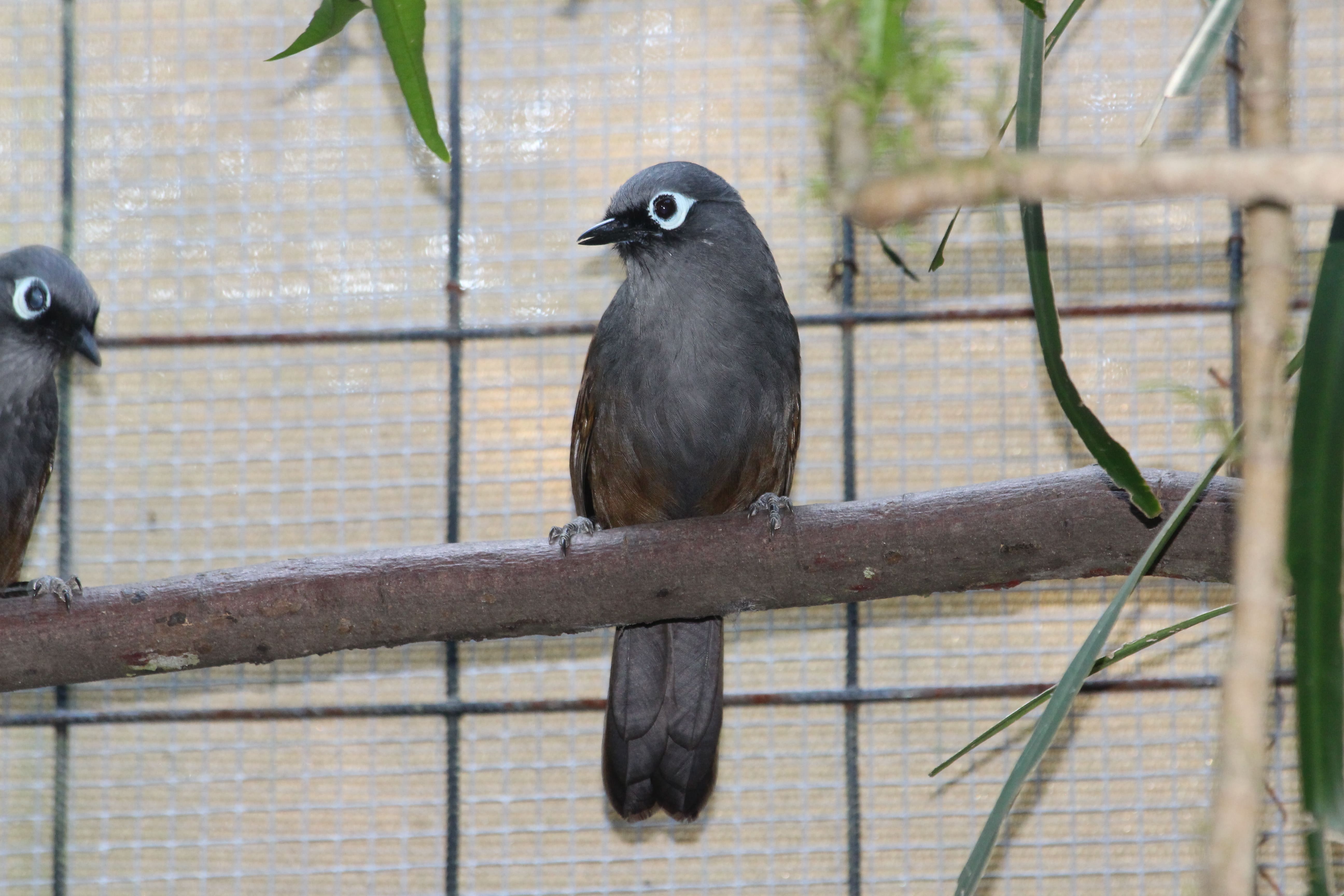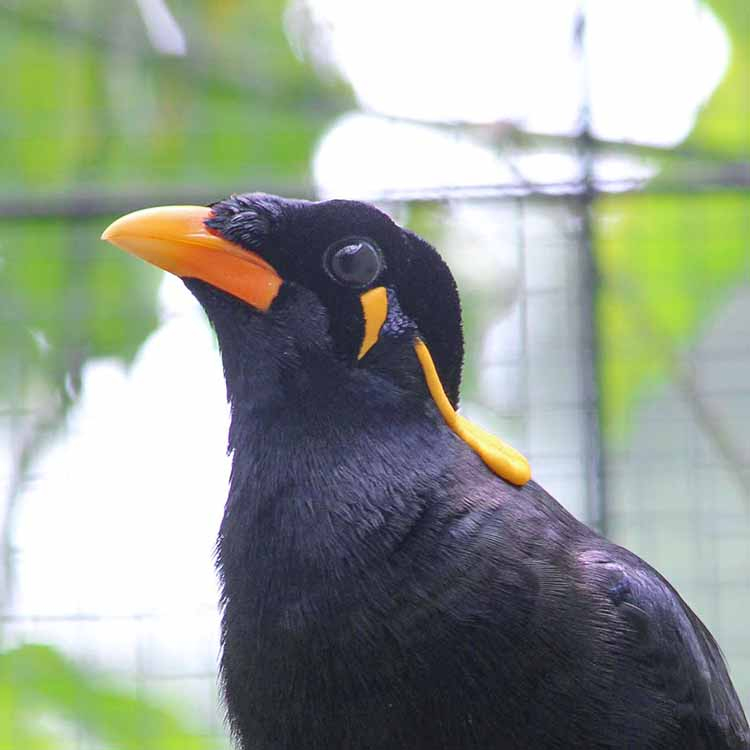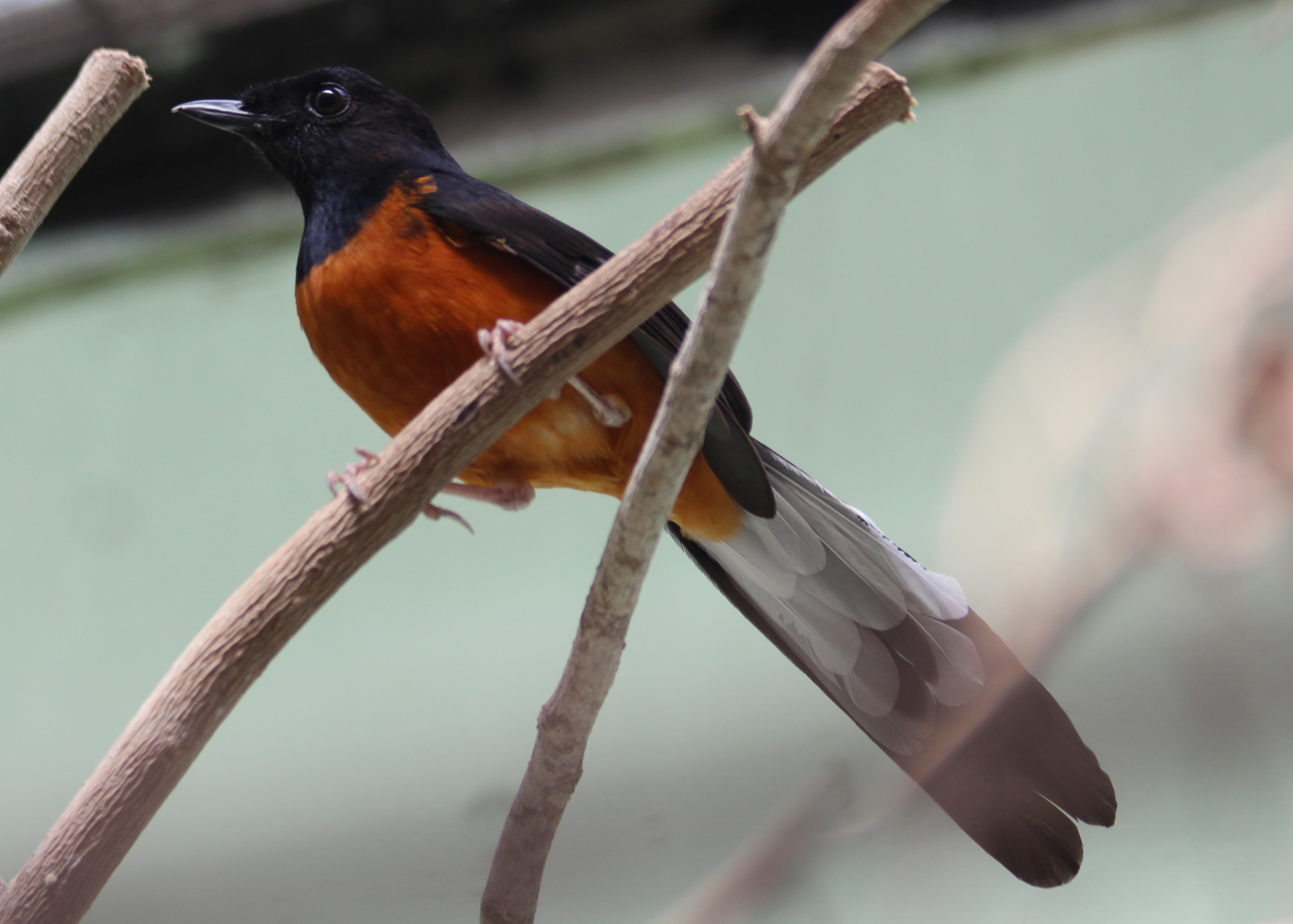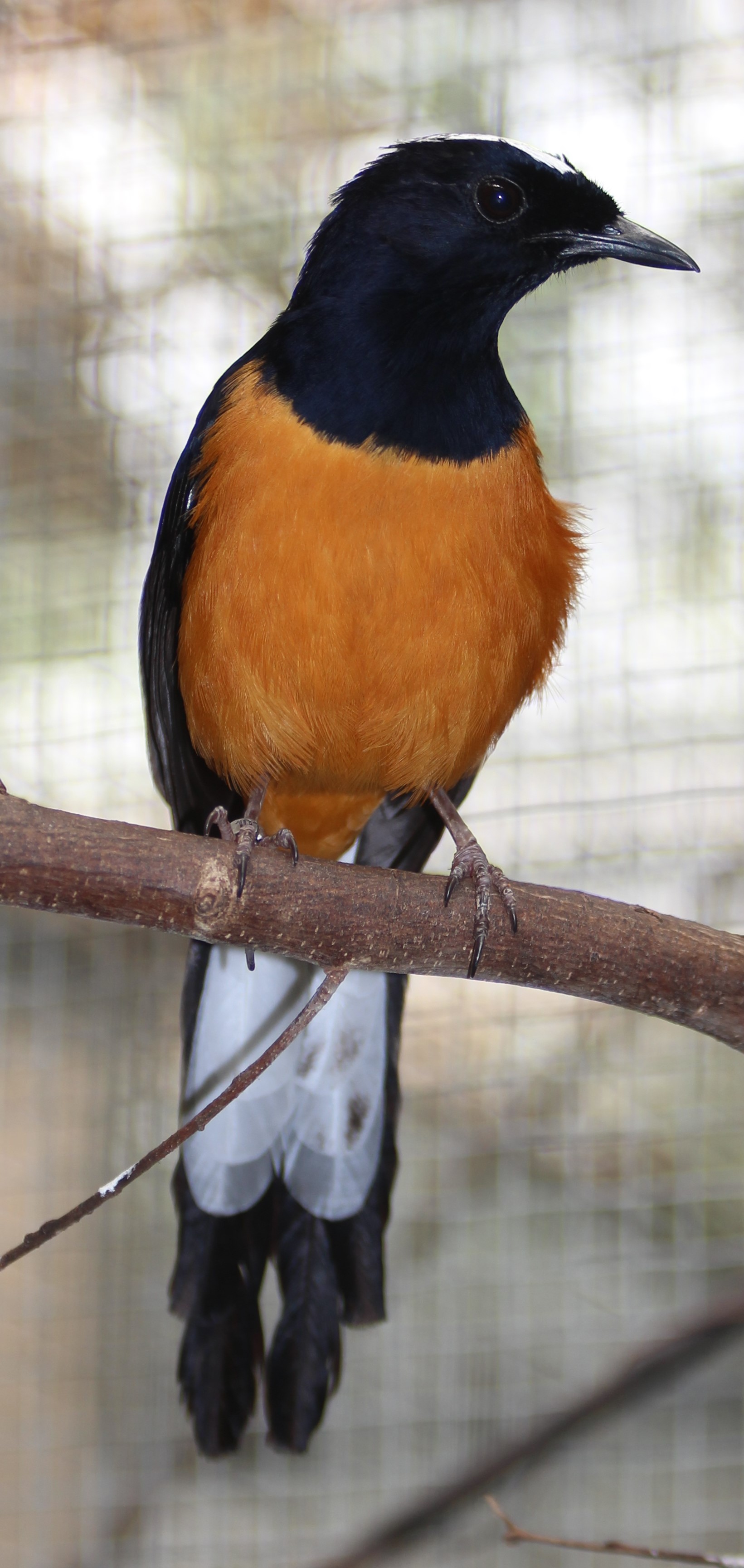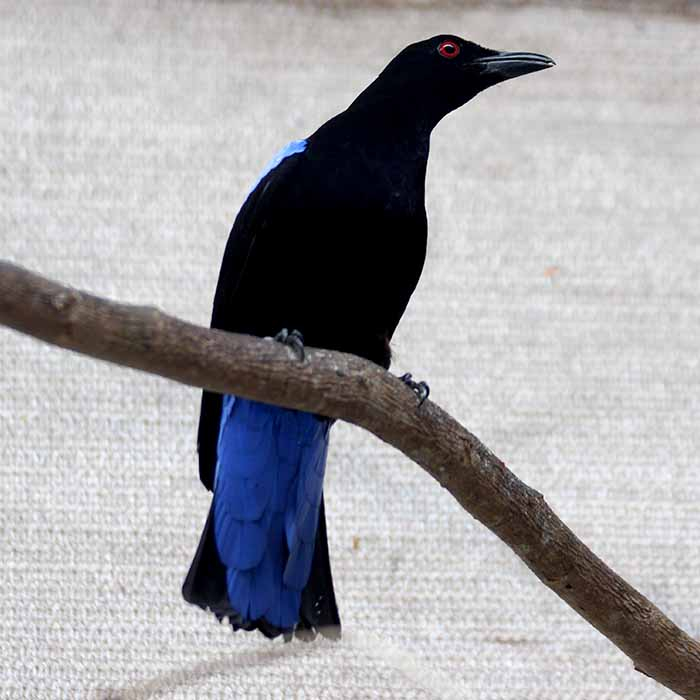Crested jayshrike
Platylophus galericulatus galericulatus
IUCN: NT (Near Threatened) assessed as species
This elusive bird is threatened by rampant poaching and habitat loss of its preferred lowland and hill forests. Its natural distribution is on Java, Indonesia. Diet is a variety of insects including caterpillars, crickets and cockroaches. Little is known about their breeding ecology.
Javan green magpie
Cissa thalassina
IUCN: CR (Critically Endangered)
An iconic bright green bird found only in the forests of west Java, it owes its colourful plumage to its diet which would otherwise be a dull pale blue. The diet is varied but mainly consists of insects and other small animals. It owes its conservation status to the rampant capture for the wildlife trade and is now close to extinction in the wild.
Ruby-throated bulbul
Rubigula dispar dispar
IUCN: VU (Vulnerable) assessed as species
This white-eyed subspecies of the ruby-throated bulbul is found in Java and faces threats from the wildlife trade. Both male and female have a similar appearance and their diet consists primarily of berries, fruit, and insects. A cup nest is built in the branches of a tree where the female generally lays two eggs.
Straw-headed bulbul
Pycnonotus zeylanicus
IUCN: CR (Critically Endangered)
A heavy target for the wildlife trade due to its loud and melodious song, it is thought to now be extinct from much of its historic range, including Java. PCBA successfully breeds this species as a part of a conservation push to save it from extinction.
Orange-spotted bulbul
Pycnonotus bimaculatus tenggerensis
IUCN: NT (Near Threatened) assessed as species
Endemic to eastern Java and Bali, this bird prefers higher altitudes and can be found in forest edges. They will build a robust cup nest in trees. The population of this subspecies faces high trapping pressure for the wildlife trade.
Javan white-eye
Zosterops flavus
IUCN: EN (Endangered)
Found in northern Java, Madura Island, and coastal west and south Borneo, this small green bird feeds primarily on insects and nectar. They can be found in groups of up to 50 birds. Classed as endangered due to a highly fragmented population as a result of habitat loss and trapping for the bird trade. PCBA holds the only known ex-situ conservation breeding population.
Wangi-Wangi white eye
Zosterops paruhbesar
IUCN: -
Found only on Wangi-wangi island, this species was only recently described to science and is already facing immense threat from habitat destruction for the tourism industry and trapping for the wildlife trade. Conservation work is underway for this bird which is a focal species for PCBA, where the only captive breeding population is kept. Their scientific name refers to their larger than normal beak for white-eye species, thought to help it get through the shell of larger and tougher insects.
Sumatran mesia
Leiothrix laurinae
IUCN: EN (Endangered)
This smaller relative of the laughingthrushes is found in Sumatra and is a heavy target for the songbird trade given its attractive appearance and song. They are omnivorous meaning they will eat both insects and fruit. They will build a small cup nest in foliage where they will lay and rear their chicks.
Rufous-fronted laughingthrush
Garrulax rufifrons rufifrons
IUCN: CR (Critically Endangered) assessed as species
This laughingthrush subspecies has an increasingly limited range in west Java and is a heavy victim of the songbird trade. Omnivorous, they will take a wide variety of food, but most often berries and insects
Mount Slamet laughingthrush
Garrulax rufifrons slamatensis
IUCN: CR (Critically Endangered) assessed as species
The Mount Slamet subspecies of the rufous-fronted laughingthrush has a restricted range to the mountain in Central Java. They are omnivorous and will take fruit, berries, and insects. Lays 2-3 eggs in a cup shaped nest. Faces immense pressure from the wildlife trade which is thought to be the main cause of its decline.
Sumatran Laughingthrush
Garrulax bicolor
IUCN: Endangered (EN)
Found in the forests of Sumatra, this species faces significant threats from the songbird trade and habitat loss. Their diet primarily consists of insects and fruit with some small animals such as geckos also taken. When breeding, the pair will construct a cup shaped nest in dense foliage where they will lay two to three eggs.
Sunda laughingthrush
Garrulax palliatus palliatus
IUCN: NT (Near Threatened) assessed as species
This subspecies of the Sunda laughingthrush is found on the forested mountains of Sumatra. For food it takes a wide range of insects, it also forages for fruit and berries, happy to go to ground as well as stay up high in the vegetation. Threatened with capture for the songbird trade, it also has a restricted range.
Javan pied starling
Gracupica jalla
IUCN: CR (Critically Endangered)
Once found throughout Java, their loud calls, striking appearance and adaptability to living in urban areas meant it was a prime target for the wildlife trade where they are also at risk from hybridisation with other pied starling species. PCBA holds a large captive population of Javan pied starlings and reintroduced a number of them to the grounds of Taman Safari Prigen in November 2022. They have since bred and reared successfully in the wild. They will nest in cavities or will build a deep round-shaped nest high up in the trees constructed from grasses, fibres, and other suitable items.
Enggano hill myna
Gracula enganensis
IUCN: -
Much like its name suggests, this species is endemic to Enggano Island off south west Sumatra. It was formally viewed as a subspecies of the common hill myna. Its body is smaller than the common. They are most commonly found along forest edges and will eat a mixture of fruits and insects.
Tenggara hill myna
Gracula venerata
IUCN: EN (Endangered)
This species occurs in the Lesser Sunda Islands and is heavily targeted by trappers for the songbird trade resulting in localised extinctions along its natural range. This is accelerated by an increase in habitat destruction as its native forests are removed. Its diet consists mostly of fruits with some nectar and insects also occasionally taken. They will occasionally take small reptiles such as geckos, particularly when rearing young.
Nias hill myna
Gracula robusta
IUCN: CR (Critically Endangered)
The largest of the hill mynas and therefore the largest bird in the starling family, they can weigh up to 400g and measure up to 36cm. They are endemic to Nias and other nearby islands off the western coast of Sumatra. Like other hill mynas, it suffers from habitat loss and capture for the songbird trade due to their renowned ability to mimic sounds. It is incredibly difficult to find in the wild and is still declining in numbers. PCBA holds a captive population to set up an ex-situ programme.
Orange-headed thrush
Geokichla citrina rubecula
IUCN: LC (Least Concern) assessed as species
This subspecies of orange-headed thrush is only found in Java and Bali where it faces immense pressure from the wildlife trade, where it is favoured for songbird competitions. Whilst globally the species is viewed as least concern, this subspecies is under threat and so PCBA holds a captive population safeguarding it for the future. A mixed diet is taken included insects and fruits.
White-rumped shama
Copsychus malabaricus suavis
IUCN: LC (Least Concern)
A hugely popular songbird across Asia and Europe making it a high target for songbird competitions. Highly insectivorous, they will take a wide variety of prey.
Barusan shama
Copsychus malabaricus melanurus
IUCN: LC (Least Concern) assessed as species
An endemic shama sub-species found on Nias island and Mentawai island both off the west coast of Sumatra. Like other shama species, they are territorial and defend their territories with their song. This makes them a prime target for the songbird trade. Sadly, this subspecies of shama is rapidly declining in numbers.
Larwo shama
Copsychus omissus
IUCN: -
The smallest of all shama species, unique once more for erecting its head feathers during display. It is endemic only to eastern Java. Shamas are incredibly territorial birds and will sing loudly and clearly as a part of territory defence, meaning they are a popular species for the songbird trade. The Larwo shama is very rarely seen or heard, pointing towards a dwindling population. PCBA holds the only ex-situ conservation breeding population of this species.
Kangean shama
Copsychus nigricauda
IUCN: -
Originally described from Kangean Island but also found on Matasiri Island, surveys have not confirmed this species in many years. Wild-caught birds are often more popular for the songbird trade than captive-bred birds, as they are thought to have better song. Shamas will take on bits of song from other birds that they hear around them, meaning over generations their song may alter slightly. PCBA holds the only ex-situ conservation breeding population of this species.
White-crowned shama
Copsychus stricklandii
IUCN: -
Endemic to the island of Borneo, this shama is characterised by its white crown. Like other shamas, it is highly prized as a cage bird and for songbird competitions, meaning the biggest threat to it in the wild is trapping to be sold for competition.
Maratua shama
Copsychus barbouri
IUCN: -
Found only on Maratua Island, this is the largest of the shama species and a core focus of PCBA’s conservation work. Recent surveys indicate that the Maratua shama might at least be functionally extinct in the wild, leaving the population at PCBA as the only hope for the species' survival. A new dedicated breeding facility for Maratua shama has just been set up in PCBA.
Javan blue flycatcher
Cyornis banyumas
IUCN: CR (Critically Endangered)
Endemic only to Java, they hunt insects in the forest understory. When breeding, a small cup nest is built where the female lays 2-3 eggs. It is particularly vulnerable to extinction due to being little known and little seen, despite once being thought of as common across Java. They are a popular target for the songbird trade.
Javan fairy bluebird
Irena puella turcosa
IUCN: LC (Least Concern) as species
A javan endemic subspecies, its numbers are declining due to habitat loss and the songbird trade. When breeding, they will construct a shallow nest high up in the trees where two eggs are generally laid. Diet consists primarily of fruit. PCBA is the only place to focus on the Javan subspecies of this bird.
Greater green leafbird
Chloropsis sonnerati
IUCN: EN (Endangered)
Prefers forest canopy, they have an omnivorous diet taking fruit, insects, and nectar. Their range includes Indonesia, the Peninsular Malaysia and Borneo. The male is identified by its striking black face and bib. The species faces immense threat from the songbird trade.
Javan leafbird
Chloropsis cochinchinensis
IUCN: EN (Endangered)
Endemic to Java, the songbird trade threatens this species with extinction, habitat loss also plays a role in this. They will feed on insects, fruit, and nectar. Nests are open cup-shaped where an average of two eggs are laid. PCBA holds an ex-situ population of this difficult species and has successfully reared offspring.

